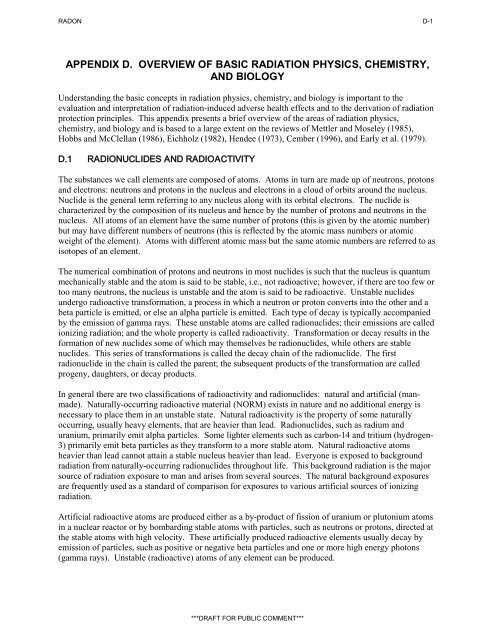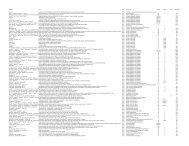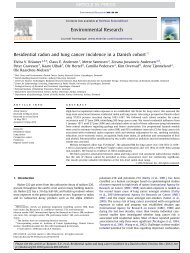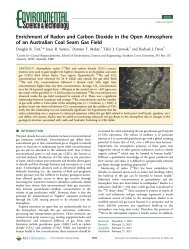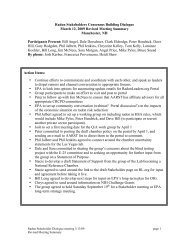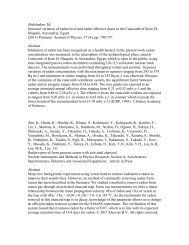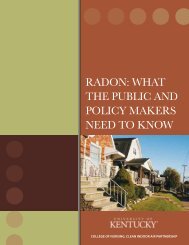ATSDR Draft Toxicological Profile for Radon_September 2008.pdf
ATSDR Draft Toxicological Profile for Radon_September 2008.pdf
ATSDR Draft Toxicological Profile for Radon_September 2008.pdf
Create successful ePaper yourself
Turn your PDF publications into a flip-book with our unique Google optimized e-Paper software.
RADON D-1APPENDIX D. OVERVIEW OF BASIC RADIATION PHYSICS, CHEMISTRY, AND BIOLOGYUnderstanding the basic concepts in radiation physics, chemistry, and biology is important to theevaluation and interpretation of radiation-induced adverse health effects and to the derivation of radiationprotection principles. This appendix presents a brief overview of the areas of radiation physics,chemistry, and biology and is based to a large extent on the reviews of Mettler and Moseley (1985),Hobbs and McClellan (1986), Eichholz (1982), Hendee (1973), Cember (1996), and Early et al. (1979).D.1 RADIONUCLIDES AND RADIOACTIVITYThe substances we call elements are composed of atoms. Atoms in turn are made up of neutrons, protonsand electrons: neutrons and protons in the nucleus and electrons in a cloud of orbits around the nucleus.Nuclide is the general term referring to any nucleus along with its orbital electrons. The nuclide ischaracterized by the composition of its nucleus and hence by the number of protons and neutrons in thenucleus. All atoms of an element have the same number of protons (this is given by the atomic number)but may have different numbers of neutrons (this is reflected by the atomic mass numbers or atomicweight of the element). Atoms with different atomic mass but the same atomic numbers are referred to asisotopes of an element.The numerical combination of protons and neutrons in most nuclides is such that the nucleus is quantummechanically stable and the atom is said to be stable, i.e., not radioactive; however, if there are too few ortoo many neutrons, the nucleus is unstable and the atom is said to be radioactive. Unstable nuclidesundergo radioactive trans<strong>for</strong>mation, a process in which a neutron or proton converts into the other and abeta particle is emitted, or else an alpha particle is emitted. Each type of decay is typically accompaniedby the emission of gamma rays. These unstable atoms are called radionuclides; their emissions are calledionizing radiation; and the whole property is called radioactivity. Trans<strong>for</strong>mation or decay results in the<strong>for</strong>mation of new nuclides some of which may themselves be radionuclides, while others are stablenuclides. This series of trans<strong>for</strong>mations is called the decay chain of the radionuclide. The firstradionuclide in the chain is called the parent; the subsequent products of the trans<strong>for</strong>mation are calledprogeny, daughters, or decay products.In general there are two classifications of radioactivity and radionuclides: natural and artificial (manmade).Naturally-occurring radioactive material (NORM) exists in nature and no additional energy isnecessary to place them in an unstable state. Natural radioactivity is the property of some naturallyoccurring, usually heavy elements, that are heavier than lead. Radionuclides, such as radium anduranium, primarily emit alpha particles. Some lighter elements such as carbon-14 and tritium (hydrogen3) primarily emit beta particles as they trans<strong>for</strong>m to a more stable atom. Natural radioactive atomsheavier than lead cannot attain a stable nucleus heavier than lead. Everyone is exposed to backgroundradiation from naturally-occurring radionuclides throughout life. This background radiation is the majorsource of radiation exposure to man and arises from several sources. The natural background exposuresare frequently used as a standard of comparison <strong>for</strong> exposures to various artificial sources of ionizingradiation.Artificial radioactive atoms are produced either as a by-product of fission of uranium or plutonium atomsin a nuclear reactor or by bombarding stable atoms with particles, such as neutrons or protons, directed atthe stable atoms with high velocity. These artificially produced radioactive elements usually decay byemission of particles, such as positive or negative beta particles and one or more high energy photons(gamma rays). Unstable (radioactive) atoms of any element can be produced.***DRAFT FOR PUBLIC COMMENT***


